
P/N IM-AR5 Rev. F
© 2017 Johnson Controls. All rights reserved. All specifications and other information shown were current as of document
revision date and are subject to change without notice.
3
DISCLAIMER.................................................................................................... 2
INTRODUCTION............................................................................................... 5
FCC Statements.................................................................................................................5
FCC Warning......................................................................................................................5
FCC Warning – RF Exposure............................................................................................5
SECTION 1 - DESCRIPTION AND FEATURES .............................................. 6
1.1 Product Description and Wireless System Overview...............................................6
1.2 Features........................................................................................................................6
1.3 Specifications ..............................................................................................................7
RB-10, 20, 30, 40 Ratings @ 24Vdc ..................................................................................7
SECTION 2 - COMPATIBILITY ........................................................................ 9
2.1 Compatible Equipment and Accessories ..................................................................9
SECTION 3 - INSTALLATION.......................................................................... 10
3.1 Preparing the Installation Site ....................................................................................10
3.2 Receiving and Unpacking the Equipment .................................................................10
3.3 Installing the AR-5 Repeater.......................................................................................10
3.3.1 Backwards Compatibility......................................................................................................................12
3.3.2 The Backup Batteries...........................................................................................................................13
3.3.3 Clearing the Base Code.......................................................................................................................13
3.3.4 Permanently Removing a Repeater.....................................................................................................13
SECTION 4 - OPERATION............................................................................... 15
4.1 Indicators, Signals and Switches...............................................................................15
4.1.1 LEDS....................................................................................................................................................15
4.1.2 Sounder ...............................................................................................................................................15
4.1.3 Dip Switch SW2...................................................................................................................................15
4.1.4 Trouble signals.....................................................................................................................................15
4.2 Outputs.........................................................................................................................16
4.2.1 Notification Appliance Circuits (TB1 Terminals 1-4)............................................................................16
4.2.2 Notification Appliance Compatibility.....................................................................................................17
4.2.3 USB Jack J35 ......................................................................................................................................18
SECTION 5 – OPTIONAL MODEL RB RELAY BOXES.................................. 18
5.1 Description...................................................................................................................18
5.2 Installation....................................................................................................................19
5.2.1 Wiring...................................................................................................................................................19
5.2.2 Programming .......................................................................................................................................19
SECTION 6 – RM-5 RELAY MODULE............................................................. 23
6.1 Description...................................................................................................................23
6.2 Installation....................................................................................................................23
6.2.1 Wiring...................................................................................................................................................23
6.2.2 Programming .......................................................................................................................................23





























